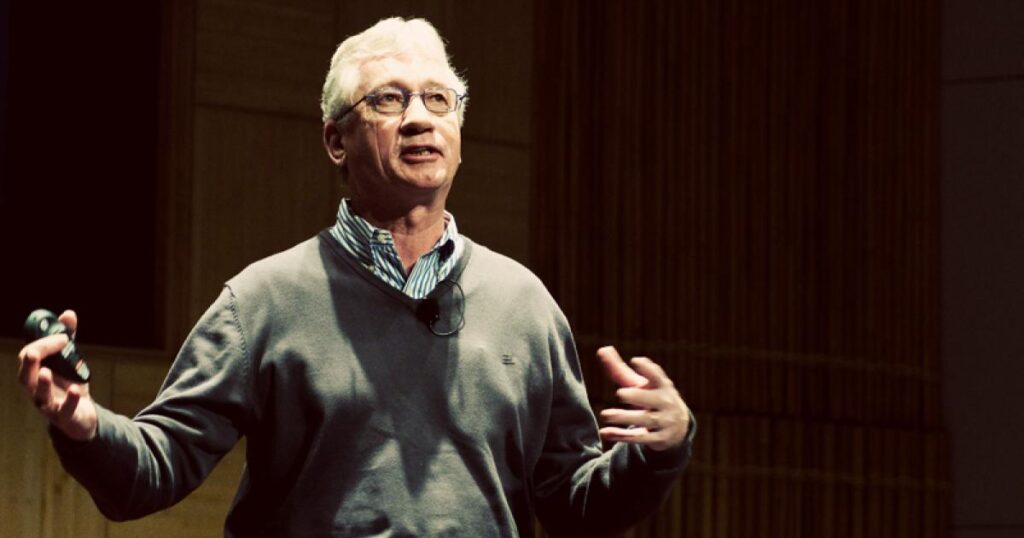Frans de Waal and the nature of kindness
4 min read
But de Wall did not walk down that road. He spent the next 45 years trying to answer the question of why that murder happened, and in what other circumstances something quite other might have happened instead.
Reconcile
His own research was mainly with captive populations, which is not that usual. The other great primatologist of our era, Jane Goodall, worked exclusively with wild chimps.
But the main reason de Waal went to Emory was that they had a long standing community of chimps with a great deal of room to roam. His office was built above their territory, with a picture window jutting out, so he could watch them every day, without interfering.
De Waal spent years thinking about two related questions. The first was, why are chimpanzees and bonobos so different? The other was, why did those two chimps kill the alpha in Arnhem Zoo?
De Waal wrote books about morality among primates. He showed that after a dominant male humiliated another male, the chimps who had watched would come and console the loser.
He showed how some males and many females would intervene in fights to protect the weaker party. And he showed how two males who had fought would often come together soon after to console each other and reconcile. He wrote a book about how scientists have consistently underestimate the intelligence of many different animals.
Stronger
Again and again, he took on and demolished arguments that insisted upon some difference or other between humans and other primates. He reduced the difference between us and them, showed us our sisters and brothers.
His work was particularly important because by looking for evolutionary uses of morality, kindness and equality in primate societies, he made it possible for scientists to see those things far more clearly in human evolution.
Mama’s Last Hug is a beautiful book about emotions in animals. De Waal shows how they can feel “love, hate, fear, shame, guilt, joy, disgust and empathy.” And of course, grief.
The name of the book comes from a short video of one of the chimps De Wall did research with in the 1970s. The scientists call her Mama, and she is 59 years old. Now she lies dying, refusing all food.
Jan van Hoog, a biologist who has known Mama for more than 40 years, approaches her carefully. He has never touched her. Both captive and wild adult chimps are dangerous, far stronger than us, and can kill or maim a human in seconds.
Competition
Van Hoog talks to Mama quietly and strokes her gently. Suddenly she knows it is him, her eyes fly open and they hug. Mama can hug van Hoog, of course, because she has been hugging other chimps all her life. Watch the video here.
De Waal’s understanding of primates was deeply influenced by the research he did with a community of captive bonobos in the San Diego Zoo in the 1980s. He was was one of the first scientists to report on bonobos, long before they were trendy.
Bonobos are a species very closely related to chimpanzees. They look the same, they eat the same food, and they move and sound the same.
But the dominant animal in a bonobo troop is always a female. Bonobos have, as is now well known, all sorts of sex, females with females, females with males, males with males, young with old. And they consistently use sex to stop fights.
De Waal eventually came up with an idea that linked his two fundamental questions. He had seen so much love, so much consolation, empathy with the weak, sympathy with the defeated and feelings of morality. And yet so much competition and cruelty too.
Evolution
De Wall took an idea from the work of Takayoshi Kano and Takeshi Furuichi with bonobos in the field. They saw that one difference between bonobos and chimps was that the bonobos lived south of the Congo River and chimps lived to the north.
And fruit was more abundant in Bonobo territory. That meant a community of bonobos usually travelled all together. Chimps, by contrast, had to split up into smaller, constantly changing, groups.
The other thing that De Waal had seen for years through that picture window in his office, was that when a fight between dominant male chimps broke out, the females and the other males would often butt in and create peace.
Then De Waal had a thought about that dreadful night in Arnhem. What the humans had done was to put the three ranking males in a cage on their own. That meant on that night, and only on that night, no other chimps had been able to intervene.
And, he thought, maybe bonobos evolved to become more peaceful because over many generations the whole group, and the females together, could dominate the bullies. And maybe, he thought, something similar happened in human evolution.
These Authors
Nancy Lindisfarne is writing a photographic ethnography of a group of pastoralists in Afghanistan in the 1970s. Jonathan Neale is writing a book about climate change in Afghanistan. They blog at annebonnypirate.org, and you can contact them at lindisfarne.neale@gmail.com.
For more on De Waal’s work and human evolution, see Nancy Lindisfarne and Jonathan Neale’s latest book, ‘Why Men? A Human History of Violence and Inequality.’ You can watch this lovely short video where De Waal explains his classic experiment on the strong feelings capuchin monkeys have about equality.





